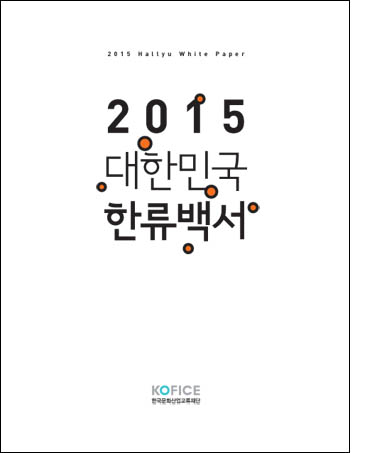| Title | 2015 Hallyu White Paper, Korea’s Comprehensive Hallyu Information Book Published. | ||||
|---|---|---|---|---|---|
| No | Inquiry | 4184 | Date | 2016/04/22 | |
<The Hallyu White Paper 2015>, a Korean comprehensive informational book on Hallyu (Korean Wave), has been published. The book was published by the Korea Foundation for International Culture Exchange (president: Yeong-jin Gwak) and was designed as a smart guide to the rapidly changing Hallyu paradigm.

The white paper is comprised of various chapters, such as “General Aspects of Hallyu,” “Hallyu Industries,” “Hallyu Locations,” “Hallyu Industrial Statistics,” “Hallyu Consumption Statistics,” “Hallyu Policies·Laws,” etc., which cover all facts and issues about Hallyu at home and abroad for the last year.
Above all, this year’s white paper sought more than a few changes in parallel to the shifting Hallyu trends. The Hallyu Industries Chapter newly included the section “Beauty Hallyu,” a key convergence business among other rising ones, while the Hallyu Locations Chapter introduced “Middle East” and “Africa” as new lands of opportunity, though Hallyu is not likely to spread in these areas as much as others. On the other hand, the Hallyu Statistics Chapter covered Consumption Statistics in addition to Industrial Statistics, analyzing the ecosystem of the Hallyu industry, which consists of “supply” and “consumption.”
In the center of Hallyu in 2015 are “great Koreans” possessing “joyful spirit,” “talent,” and “innovation” in their blood as well as a “distribution system that evolves day by day.” Some representative Hallyu stars, including Min-ho Lee, Soo-hyun Kim, EXO, and Big Bang have shown exceptional performances in the frontline of the industry, solidifying their position as wannabe stars for global fans. In the movie and television sector, creative professionals armed with technologies and ideas actively tried to go global, which is further boosted by the export of the contents format and joint production, leading the phenomenon called the “glocalization” of Hallyu. In addition, webtoons, the next-generation Hallyu content, has been continuously rolling, based on the wired/wireless platform in the global web contents market. Meanwhile, Korean food has been adopting a modernized system such as a fast-food system or the launching of dining brands, etc., thus taking one step closer to the “globalization of K-Food.”
As the challenges of Hallyu toward the global stage persisted in 2015, a variety of features were shown in each area. While China further strengthened its position as a major consumer of Hallyu, Japan and Southeast Asia—traditionally considered as strongholds of Hallyu—saw that Hallyu was relatively intimidated by the difference in political·social·cultural point of views. In Latin America, K-drama triumphantly entered the telenovela market, while the kinds of Hallyu products became even more diversified in Western Europe and the Middle East.

